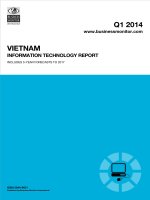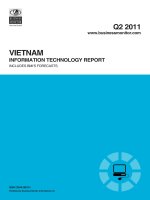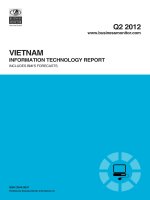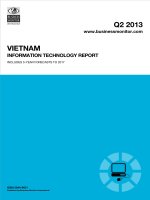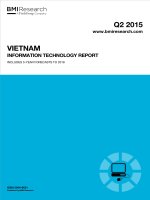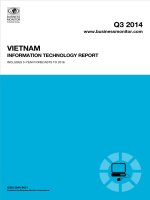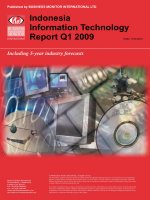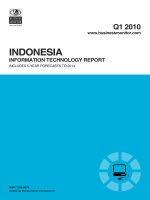Indonesia information technology report q2 2014
Bạn đang xem bản rút gọn của tài liệu. Xem và tải ngay bản đầy đủ của tài liệu tại đây (445.64 KB, 79 trang )
Q2 2014
www.businessmonitor.com
INDONESIA
INFORMATION TECHNOLOGY REPORT
INCLUDES 5-YEAR FORECASTS TO 2018
ISSN 1750-5070
Published by:Business Monitor International
Indonesia Information Technology
Report Q2 2014
INCLUDES 5-YEAR FORECASTS TO 2018
Part of BMI’s Industry Report & Forecasts Series
Published by: Business Monitor International
Copy deadline: January 2014
Business Monitor International
Senator House
85 Queen Victoria Street
London
EC4V 4AB
United Kingdom
Tel: +44 (0) 20 7248 0468
Fax: +44 (0) 20 7248 0467
Email:
Web:
© 2014 Business Monitor International
All rights reserved.
All information contained in this publication is
copyrighted in the name of Business Monitor
International, and as such no part of this
publication may be reproduced, repackaged,
redistributed, resold in whole or in any part, or used
in any form or by any means graphic, electronic or
mechanical, including photocopying, recording,
taping, or by information storage or retrieval, or by
any other means, without the express written consent
of the publisher.
DISCLAIMER
All information contained in this publication has been researched and compiled from sources believed to be accurate and reliable at the time of
publishing. However, in view of the natural scope for human and/or mechanical error, either at source or during production, Business Monitor
International accepts no liability whatsoever for any loss or damage resulting from errors, inaccuracies or omissions affecting any part of the
publication. All information is provided without warranty, and Business Monitor International makes no representation of warranty of any kind as
to the accuracy or completeness of any information hereto contained.
CONTENTS
BMI Industry View 7
SWOT 9
IT 9
Wireline SWOT 11
Political 13
Economic 15
Business Environment 17
Industry Forecast 18
Table: Indonesia IT Industry - Historical Data And Forecasts (IDRbn) 18
Broadband 23
Table: Internet - Historical Data And Forecasts, 2012-2018 23
Macroeconomic Forecasts 25
Current Account Mending Slowly 26
GDP Buffeted By Triple Headwinds 27
Table: Indonesia - Economic Activity 28
Industry Risk Reward Ratings 29
Table: Asia Pacific IT Risk/Reward Ratings - Q2 2014 31
Market Overview 32
Hardware 32
Software 39
IT Services 45
Industry Trends And Developments 48
Regulatory Development 52
Table: Key Ministers And Departments 52
Competitive Landscape 55
International Companies 55
Table: Lenovo Indonesia 55
Table: Intel Indonesia Corporation 56
Table: Microsoft Indonesia PT 57
Table: IBM Indonesia 58
Table: Foxconn Technology 59
Local Companies 60
Table: Performance PT Multipolar Technology Tbk (MLPT) 60
Table: Walden Global Services (WGS) 61
Table: Aprisma Indonesia 61
Table: ALTiUS ERP 62
Indonesia Information Technology Report Q2 2014
© Business Monitor International Page 4
Company Profile 63
Sigma 63
Regional Overview 66
Hardware Sales Opportunity Remains 68
Demographic Forecast 70
Demographic Outlook 70
Table: Indonesia's Population By Age Group, 1990-2020 ('000) 71
Table: Indonesia's Population By Age Group, 1990-2020 (% of total) 72
Table: Indonesia's Key Population Ratios, 1990-2020 73
Table: Indonesia's Rural And Urban Population, 1990-2020 73
Methodology 74
Industry Forecast Methodology 74
Sources 75
Risk/Reward Ratings Methodology 76
Table: It Risk/Reward Ratings Indicators 77
Table: Weighting Of Components 78
Indonesia Information Technology Report Q2 2014
© Business Monitor International Page 5
BMI Industry View
BMI View: We expect the Indonesian IT market will be a regional outperformer over the medium term, on
the back of strong economic growth, a low PC penetration rate and an emerging middle class. Retail
hardware, enterprise software and cloud computing are expected to be key drivers of medium-term growth.
The retail market will be the major driver of growth, with PC penetration estimated at below 10% in 2012,
meaning there is significant growth potential from first-time buyers and upgrades/personal
devices. However, vendors face short-term challenges in the form of a depreciation of the rupiah, which has
raised the cost of dollar denominated hardware and software imports. In the immediate future, IT spending
is forecast to increase to IDR69.7trn in 2014, up 12.3% from 2013, with the IT market accounting for
0.67% of GDP.
Headline Expenditure Projections
Computer Hardware Sales: IDR49.0trn in 2014 to IDR75.4trn in 2018, at a compound annual growth rate
(CAGR) of 11.3% in local currency terms. Short-term growth will be limited by rupiah depreciation, but
availability of low-cost tablets will maintain positive growth. We expect stronger medium-term growth as
the economic environment becomes more supportive.
Software sales: IDR8.6trn in 2014 to IDR15.6trn in 2018, at a CAGR of 16.1% in local currency terms.
Government initiatives to reduce piracy, including a roadshow to bring down illegal software use, will boost
medium term spending - but in the short term the key demand driver will be enterprise software
deployments.
IT Services Sales: IDR12.0trn in 2014 to IDR20.2trn in 2018, at a CAGR of 14.0% in local currency terms.
Our forecast has been downwardly revised, but a key growth area is cloud services, which could be worth
more than IDR15.5trn by 2018.
Key Trends & Developments
In the short term an important trend impacting the development of the IT market is the depreciation of the
rupiah, putting upward pressure on the price of imported hardware and software. For instance, in September
2013 global PC market leader Lenovo announced plans to raise prices of its PCs by about 20% in
Indonesia. This will lead to some deferred sales in the PC market, where consumers remain highly price
Indonesia Information Technology Report Q2 2014
© Business Monitor International Page 7
sensitive. An additional trend could be additional momentum granted to lower-cost tablets, particularly from
local and regional OEMs producing devices running Google's Android OS.
Another challenge to the continued growth of the IT market is from the uncertainty created by the lack of
cyber security measures. In October 2013, it was reported that Indonesia is responsible for 38% of the
world's malicious internet traffic, surpassing China as the leading root of online attacks. This has grown
from only 0.7% of recorded attacks 12 months previously, according to the US-based Akamai
Technologies. The reasons behind the growth are under debate, but the implications of a dramatic increase
in online attacks have worried officials. Cyber security is notoriously weak in Indonesia. The second-
highest cause of the 1.2mn daily attacks recorded by the government is attempts at data theft. Network-
heavy industries, such as oil and gas, are most susceptible to data phishing attempts.
Indonesia Information Technology Report Q2 2014
© Business Monitor International Page 8
SWOT
IT
SWOT Analysis
Strengths
■
Large potential market.
■
Th market may be entering a faster growth stage. It is forecast to grow quicker than
most other Association of South East Asian Nations (ASEAN) markets over the
forecast period, due to its underdeveloped nature.
Weaknesses
■
Computer penetration is among the lowest in South East Asia, estimated at only 9%
in 2012.
■
Underdeveloped telecommunications infrastructure, due to years of government
control and slow progress in deregulation.
■
Lack of government support, and there is still no unified ICT ministry.
■
History of recent political instability.
■
High piracy rate continues to be a drag on the software market, with one of the
highest piracy rates in the region.
■
Indonesia overtook China as the largest source of cyber attack traffic in 2013, with
cyber threats becoming an increasingly important issue for domestic users as well.
Opportunities
■
Some positive trends: computer ownership and internet access are on the rise, and
the government is showing signs of taking intellectual property more seriously.
■
Strong demand for tablets and low-cost laptops from a youthful population and
booming economic performance.
■
Per capita IT spending to increase rapidly as the middle class increases in size.
■
Opportunities exist in services such as system integration, support systems, training,
professional services, outsourcing and internet services.
Indonesia Information Technology Report Q2 2014
© Business Monitor International Page 9
SWOT Analysis - Continued
■
IT services, with local telcos investing heavily in data centres, networks, machine-to-
machine communication and cloud computing services.
Threats
■
Continuing lack of government action to support increased PC penetration and
internet access, or drive ICT sector development.
■
The global economic slowdown may hit key demand segments.
■
A weaker rupiah could have a dampening effect on household and business
spending.
Indonesia Information Technology Report Q2 2014
© Business Monitor International Page 10
Wireline SWOT
SWOT
Strengths
■
Fixed-wireless offers a balance between fixed line and mobile at affordable prices and
has experienced strong demand, helping to boost overall fixed-line subscriber figures
in an otherwise slowing market.
■
Increased competition in the fixed-wireless market following the award of nationwide
licences to Bakrie Telecom and Smartfren.
Weaknesses
■
Lack of competition in the fixed-line market with Telkom dominating with an 80%-
plus market share.
■
Low teledensity rates, especially in the fixed-line sector.
■
Limited available capital via loans could hinder further progress of the broadband
market.
■
Poor fixed-line infrastructure means limited internet accessibility in rural areas.
Opportunities
■
Plenty of opportunities for broadband growth, with a higher number of operators
awarding contracts to the likes of Nokia Siemens Networks and Ericsson.
■
Submarine cable projects are on the rise, connecting Indonesia to regional peers such
as Hong Kong and then onwards to Singapore and Vietnam.
■
Solid economic outlook led by domestic demand should aid growth of the telecoms
industry.
Indonesia Information Technology Report Q2 2014
© Business Monitor International Page 11
SWOT - Continued
Threats
■
Uneven development between urban and regional areas could be further
exaggerated, with current broadband contracts centring on the larger islands of Java
and Sumatra.
■
The cost of PCs and tariffs could place internet and broadband services out of the
reach for the majority of Indonesians.
■
Growing preference in the consumer segment for mobile broadband solutions.
Indonesia Information Technology Report Q2 2014
© Business Monitor International Page 12
Political
SWOT Analysis
Strengths
■
Indonesia managed a successful transition to democracy in 2004. In addition, the
2009 parliamentary and presidential elections passed peacefully, signalling the
consolidation of the democratic process. Following 2009, the government showed
further signs of improvement in both efficacy and engagement, but progress has
stagnated since 2012.
■
The military's role in politics has gradually been reduced. The prospects of a military
coup - which seemed a real possibility in the late 1990s and early 2000s - have
diminished substantially. As the military's role in politics continues to wane,
Indonesia's political stability should likewise improve.
Weaknesses
■
Indonesia's domestic political scene is characterised by a proliferation of minority
parties, and formal and informal coalitions are necessary to govern and legislate.
Moreover, the efficiency of state institutions is encumbered by bureaucracy and
corruption. Prospects for reform are beset with numerous challenges, such as the
long-running practice of politicians promising government positions to campaign
supporters.
■
The country was impacted by separatist rebellion and ethnic violence in the late
1990s and early 2000s, which took great efforts to bring to heel. In the event of a new
economic crisis, calls for regional secession could re-emerge.
Opportunities
■
President Susilo Bambang Yudhoyono's Democratic Party had a strong showing in
the 2009 parliamentary elections. Coupled with a strong mandate following his re-
election in the same year, the implementation of policies in the legislature should
become less problematic.
■
Indonesia's status as the world's most populous Muslim country leaves it well
positioned to speak out on global Islamic issues and act as a bridge between the
Middle East and the Asia Pacific region.
Indonesia Information Technology Report Q2 2014
© Business Monitor International Page 13
SWOT Analysis - Continued
Threats
■
Regional militant group Jemaah Islamiah poses a lingering threat to security in
Indonesia. Jemaah Islamiah is blamed for a series of attacks, including the Bali
bombings of October 2002 and the Jakarta bombings of July 2009.
■
The fact that Indonesia subsidises basic goods means that when the government
raises prices, there is a risk of public unrest, or at least a political backlash.
Additionally, Indonesia's population is extremely young, with more than 50% of
Indonesians younger than 30. Younger populations have historically been a predictor
of political instability.
Indonesia Information Technology Report Q2 2014
© Business Monitor International Page 14
Economic
SWOT Analysis
Strengths
■
Indonesia's strategic location between the Indian and Pacific Oceans and its
adjacency to major east-west trade routes make it an important economy in the
region. Indonesia is also resource-rich and is the world's largest producer of palm oil.
■
Indonesia has a low cost and large supply of available labour resources. Its labour
force, the fourth-largest in the world, is also one of the world's youngest.
Weaknesses
■
Indonesia's economy is not growing fast enough to reduce unemployment, with the
rate still relatively high at 5.9% as of Q113. Many are forced to work in the informal
sector. Of particular concern is the youth unemployment rate, which is five times the
overall rate.
■
Indonesia's physical infrastructure is considered sub-standard. The archipelagic
nature of the country makes it difficult to weave national infrastructure together.
Despite an ambitious infrastructure revitalisation plan, the country currently compares
unfavourably with its Association of Southeast Asian Nations peers.
Opportunities
■
Indonesia could attract much-needed foreign investment by strengthening its
business environment, particularly through reform of its unreliable legal system.
■
Indonesia stands to benefit from the rise of Islamic financing, having adopted new
legislation in early 2008 designed to tap into this rapidly expanding sphere. With an
overall market share of only 3%, growth prospects for Islamic banking in the world's
largest Muslim country are enormous.
Threats
■
Production at Indonesia's ageing oil fields has been in decline since the mid-1990s.
The country has therefore become a net importer of crude oil in recent years, putting
downward pressure on its current account position. Furthermore, rising oil prices
have begun to pressure Indonesia's current account, where it typically runs a healthy
surplus. The resumption of the Cepu field, which occurred in late 2009, may help to
alleviate Indonesia's dependence on foreign oil given its small boost to production
output, but we expect this bounce to be short-lived.
Indonesia Information Technology Report Q2 2014
© Business Monitor International Page 15
SWOT Analysis - Continued
■
Indonesia is perceived as one of Asia's riskier destinations. This leaves the economy
vulnerable to sudden capital outflows at times of risk aversion, which can lead to
sharp swings in the currency.
Indonesia Information Technology Report Q2 2014
© Business Monitor International Page 16
Business Environment
SWOT Analysis
Strengths
■
Indonesia is South East Asia's largest economy with a nominal GDP of US$880bn and
is the world's fourth most populous country with more than 240mn people. It thus
offers investors a vast home market in which to do business.
■
As a member of the Association of South East Asian Nations' Free Trade Area,
Indonesia is committed to lowering tariff and non-tariff barriers to trade.
Weaknesses
■
Corruption remains a major problem. Indonesia ranked 118th out of 176 countries
surveyed in Transparency International's 2012 Corruption Perceptions Index, where a
low ranking denotes a higher degree of corruption.
■
Indonesia's excessive bureaucracy makes it a difficult place to do business. Among
Asian economies, Indonesia has the longest period to start a business. Labour laws
are also considered excessive.
Opportunities
■
President Susilo Bambang Yudhoyono's administration has gradually been reforming
the business environment, particularly by strengthening the legal system and fighting
corruption. If sustained, this would boost investor interest in Indonesia. However,
reform has been slow, and divisions within the government could curb progress
ahead of 2014 elections.
■
Indonesia has been amending its debt and banking regulations, with the aim of
attracting Islamic financial activities. Over the past five years, Islamic banking growth
has averaged more than 65%.
Threats
■
Recent high-level business disputes between the government and foreign investors
demonstrate that even after investments are up-and-running, there is still scope for
legal problems or obstacles posed by legal wrangling.
Indonesia Information Technology Report Q2 2014
© Business Monitor International Page 17
Industry Forecast
Table: Indonesia IT Industry - Historical Data And Forecasts (IDRbn)
2011 2012 2013e 2014f 2015f 2016f 2017f 2018f
IT Market Value 46,571.0 54,646.4 62,023.6 69,658.7 78,595.9 88,451.9 99,322.6 111,221.4
o/w Hardware 33,694.1 39,181.4 44,067.8 49,039.7 54,820.7 61,120.2 67,986.3 75,408.1
- PC 27,359.6 32,128.8 36,488.1 40,604.9 45,501.2 50,729.8 56,428.6 62,588.8
- Servers 3,032.5 3,526.3 3,966.1 4,413.6 4,933.9 5,500.8 6,118.8 6,786.7
o/w Software 5,215.9 6,339.0 7,442.8 8,637.7 10,060.3 11,675.6 13,507.9 15,571.0
o/w Services 7,660.9 9,125.9 10,513.0 11,981.3 13,715.0 15,656.0 17,828.4 20,242.3
IT Market, % of GDP 0.63 0.66 0.67 0.67 0.67 0.68 0.68 0.68
e/f = BMI estimate/forecast. Source: BMI
BMI extended the forecast for the Indonesian IT market to 2018 in the Q214 update. Our positive outlook
for Indonesia is maintained and we expect it to be a regional and global outperformer over the duration of
our forecast period. However, we also made a minor downgrade to the outlook for 2014 on the basis of a
weaker rupiah, which negatively hit demand for imported products.
Despite the short-term drag on growth we expect strong medium term growth based on positive
fundamentals in the IT market. Rising incomes along with low computer penetration and growing
affordability as device prices decline should ensure the market remains firmly in positive growth territory.
Meanwhile, we expect strong growth in enterprise demand over the medium term as modernisation
initiatives gather pace. We forecast a compound annual growth rate (CAGR) of 12.4% 2014-2018, with
Indonesia's IT market reaching a total value of IDR111trn in 2018.
Indonesia Information Technology Report Q2 2014
© Business Monitor International Page 18
2014 Outlook
The overall economic environment remains
conducive for IT market expansion in 2014, however
currency weakness will weigh on sales. BMI
forecasts 5.4% real GDP growth in 2014 and 4.7%
real private final consumption growth, which will
see confidence levels remain high and boost retail
spending. However, with large numbers of products
and components imported to Indonesia the
depreciation of the rupiah will raise prices. This will
be a drag on spending growth, magnified compared
to developed markets because of the price sensitive
nature of the market.
The weaker rupiah is also a symptom of wider
concerns about Indonesia's exposure to global
headwinds. The sentiment towards emerging
markets has shifted fast in early 2014, and although
BMI's core view is for robust growth in Indonesia, business IT investment will be susceptible to shifting
confidence, with Indonesian enterprises adopting a wait-and-see approach to hardware and systems
upgrades in the face of concerns about Indonesia's exposure to economic headwinds.
A key are of growth in 2014 will be the hardware market, which is expected to account for 70.4% of total
spending. Imported products will be hurt by higher prices but lower cost imports from other East Asian
markets, notably tablets from Chinese OEMs, and domestically produced notebooks and tablets are
expected to see strong sales. There is a large growth opportunity in Indonesia with individual PC
penetration around 10%. Meanwhile household PC penetration reached 15.1% in 2012, less than half the
APAC average of 31% and below the global emerging market average of 27.6%. When this is considered
alongside Indonesia's huge population and trajectory of rising incomes enabling the emerging middle class
to acquire their first household computing device, the scale of the opportunity is apparent.
Government initiatives will also contribute to growth momentum in 2014. The development policy aiming
to lift Indonesia into the ranks of the world's top 10 economies by 2025 should fuel ICT investment.
Spending in some key IT verticals, such as financial services and banking, will be central to growth in
Industry Trends - IT Market
2011-2018
e/f = BMI estimate/forecast. Source: BMI
Indonesia Information Technology Report Q2 2014
© Business Monitor International Page 19
enterprise IT spending. However, there is also great potential in currently underpenetrated sectors, such as
manufacturing. Adoption of cloud computing services by enterprises will also increase, and we identify the
SME market as a large medium term opportunity.
Direct spending by the government on infrastructure will boost the market in 2014. Government IT
spending is expected to increase and continue to account for around 25% of the IT market, while the
government is also encouraging state companies to use more IT.
Market Drivers
Over the medium term IT hardware will continue to be the single largest segment of the IT market. The
share of hardware will decline slightly over the medium term, but with Indonesia remaining in a phase of
rapid growth for the duration of our forecast this decline will only be small. We estimate the hardware
market accounted for 70.4% of sales in 2014, which will decrease to 67.8% by 2018. We forecast hardware
sales will reach a value of IDR75.4trn in 2018, with Indonesia achieving faster growth than many other
ASEAN members. Low PC penetration and efforts to promote regions beyond Jakarta will benefit hardware
sales in the retail market. However, Indonesia's uneven development and digital divide remain major
barriers to faster growth within this potentially huge IT market.
The enterprise market will also boost spending on IT products and services as modernisation initiatives are
undertaken by firms looking to expand into neighbouring markets and/or defend domestic positions. Private
enterprises, particularly SMEs, will provide a large part of PC sales, while ERP and other e-business
applications are also finding increasing popularity in the SME market. The SME sector of 42.2mn
companies will drive demand for basic hardware and applications, as enterprises look to enhance
productivity through automating inventory, accounting and other functions.
Around 30-35mn Indonesian companies are estimated to lack any IT-based solutions. IT services for this
segment will be dominated by basic services such as system integration, support systems, training,
professional services, outsourcing and internet services. There is also an opportunity for cloud computing
vendors in the SME market, but this market will only open up as telecoms operators invest in improving
wireless and wireline broadband infrastructure.
A more active approach by the government to encourage IT development, including the establishment of the
National ICT Council, headed by President Yudhoyono, should stimulate spending through a series of
infrastructure and education initiatives. The Indonesian government's Master Plan for Acceleration and
Expansion for Indonesia Economic Development (MPEEI) states that connectivity between the islands of
Indonesia Information Technology Report Q2 2014
© Business Monitor International Page 20
the country is a priority area. Major government infrastructure and ICT initiatives, particularly the Palapa
Ring Project, have been rolled out to create the infrastructure to support IT market growth. Cheap computer
programmes are likely to be favoured, as increasing internet penetration and computers in schools
programmes are believed to represent potential demand for up to 25mn units.
Segments
The enterprise hardware market will remain robust for the duration of our forecast, and continue to produce
strong demand for desktops. However it is in the consumer market where there will be faster growth and
more dynamism. Demand for traditional notebooks is being eroded by the popularity of new form factors,
particularly tablets, but BMI expects hybrids/convertibles could gain traction as prices decline, with first-
time buyers likely to see multi-functionality as a major positive.
In the short term though it is tablets that are the dominant trend, for instance, Taiwanese vendor Asus
estimated that tablets account for 50% of its Indonesian sales in 2013.Low-cost tablets running Android,
particularly from OEMs in China, are expected to prove particularly popular with Indonesian consumers.
The government's plans to establish fixed wireless networks in major cities and encourage WiMAX build-
out in rural areas will also be drivers. There are also an increasing number of Wi-Fi 'hotspots'. Telecoms
operators are increasingly pushing tablets as devices to bundle with wireless data subscriptions as a means
of winning market share and increasing network usage.
While the emerging middle class in Indonesia is promoting consumption, a large portion of sales are reliant
on government initiatives to increase penetration. It will remain dominated by the lower-price tiers, which
will account for about 80% of sales. The popularity of lower-cost netbook computers, which flooded the
market a few years back, has helped to sustain volume sales, but demand for the devices has dropped off
sharply - largely replaced by tablets, but also by low-cost and slimline notebooks. Computer sales will also
receive a boost from programmes to increase computer penetration in education, as the government seeks to
meet its growth targets for this sector.
Increased corporate demand for IT products and services will reflect a growing awareness of the value of
technology in various sectors. Despite cutbacks due to the financial crisis, the financial services segment
will continue to be significant, with spending on regulatory compliance and security, for example, less
susceptible to cutbacks. The market also remains relatively under-penetrated, with IT implementations
largely limited to transactional support. Islamic banking also presents strong growth opportunities over the
next few years.
Indonesia Information Technology Report Q2 2014
© Business Monitor International Page 21
Another potential demand driver will be organisations looking for help to utilise efficiencies from cloud
computing, such as SaaS and infrastructure-as-a-service. The cloud computing market is currently small in
absolute terms, at less than IDR2bn, but in H111 IT giants such as PT Telkom and Microsoft launched
cloud services in Indonesia, driving the development of the market by offering new services and increasing
levels of education among customers about potential uses.
Summary
The value of the hardware market is predicted to grow from IDR49.0trn in 2014 to IDR75.4trn in 2018,
with PC sales (including accessories) rising from IDR40.6trn to IDR62.6trn. Software spending is forecast
to rise from IDR8.6trn to IDR15.6trn, and IT services spending is expected to increase from IDR12.0trn to
IDR20.2trn.
Indonesia Information Technology Report Q2 2014
© Business Monitor International Page 22
Broadband
Table: Internet - Historical Data And Forecasts, 2012-2018
2012 2013e 2014f 2015f 2016f 2017f 2018f
No. of internet users ('000) 37,597 45,116 50,981 55,569 58,348 61,265 64,328
No. of internet users/100 inhabitants 15.2 18.1 20.2 21.7 22.6 23.4 24.4
No. of broadband internet subscribers ('000) 2,983 3,222 3,383 3,552 3,729 3,841 3,880
No. of broadband internet subscribers/100
inhabitants 1.2 1.3 1.3 1.4 1.4 1.5 1.5
e/f = BMI estimate/forecast. Source: BMI. ITU, Kominfo, operators
New data from the ITU show that there were approximately 37.6mn internet users in Indonesia at the end of
2012, up from 29.8mn a year earlier. These figures are lower than those previously reported, although it
remains unclear why the data have been revised downwards. Kominfo, the agency charged with publishing
statistical analyses of the postal and communications markets, has not disclosed any useful information
since 2010. Therefore, BMI is using the new ITU figures and adjusting its five-year forecast to 2018 to
account for the newly revealed market growth dynamic.
The ITU data also show that there were 2.983mn fixed broadband subscribers in the country at the end of
2012, up from 2.736mn a year earlier. This is broadly in line with our previous estimate for 2012, so there is
only a small change to our forecast for fixed broadband adoption.
We are yet to include mobile broadband connections in the forecast owing to a lack of clarity from
operators regarding the number of dedicated mobile broadband connections (those that are primarily non-
voice in nature). However, the top three operators indicate that there is a high level of usage of non-voice
services, although we note considerable quarterly variations in growth.
BMI expects Indonesia's fixed broadband industry to exhibit a steady growth trajectory with increasing
service adoption mainly in urban cities among businesses and more affluent consumers that require higher-
speed connectivity. The masses' generally low purchasing power and lack of need for high-speed broadband
services mean that 3G-based mobile broadband services will continue to struggle to achieve traction in the
medium term. We forecast 3.841mn fixed broadband subscribers by 2017, representing a penetration rate of
just 1.5%, up from 1.2% in 2012.
Indonesia Information Technology Report Q2 2014
© Business Monitor International Page 23
Industry Trends - Broadband Sector
2012-2018
e/f= BMI estimate/forecast. Source: BMI, ITU, Kominfo, operators
Indonesia Information Technology Report Q2 2014
© Business Monitor International Page 24
Macroeconomic Forecasts
BMI View: As expected, Indonesia's August trade surplus was a one-off, with the country's trade account
returning to deficit in September. All told, Q313's current account deficit is likely to come in slightly from
Q213's record 4.4% of GDP print, but we continue to believe that the improvement in Indonesia's external
position will be a gradual one. Meanwhile, real GDP growth slowed yet again to 5.6% year-on-year (y-o-y)
in Q313 as the triple headwinds of the country's external imbalance, high inflation, and rising borrowing
costs hit economic activity. As this slowdown continues to play out, we have downgraded our 2013 real
GDP forecast slightly to 5.7% (from 5.8 previously), and maintain our expectations for the rate of
expansion to ease further to 5.4% in 2014.
In line with our expectations, Indonesia's trade balance slipped back into the red in September, flipping
from a slight (downwardly revised) surplus of US71.6mn in August to a deficit of US$657.2mn. The result
should have been of little surprise to markets, as August's surplus was a clear outlier that arrived as a result
of a particularly weak month of imports (-25.3% month-on-month [m-o-m] in August) as opposed to a boost
in exports, which also experienced a substantial 13.4% m-o-m drop. All told, Indonesia's Q313 trade deficit
position, which includes a record US$2.3bn deficit in July, improved only slightly to US$2.9bn from US
$3.1bn in Q213.
Back Into The Red
Indonesia - Exports & Imports, % chg y-o-y (LHS) & Trade Balance, US$mn
Source: BMI, Statistics Indonesia
Indonesia Information Technology Report Q2 2014
© Business Monitor International Page 25
